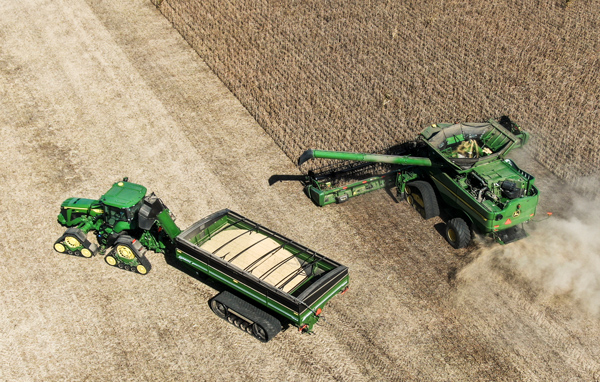【By Guan察者网, Yuan Jiaqi】
As soybeans enter the harvest season, American farmers who have lost Chinese customers are facing a "battle for survival".
According to the Wall Street Journal on the 7th, under the dual pressures of rising equipment and fertilizer costs and an oversupply of corn and soybeans, the financial situation of American soybean farmers has become precarious. To calm the farmers' emotions, the US Congress passed a $10 billion agricultural relief plan in December last year. The Trump administration is considering adding another $10 billion to $14 billion in funds to alleviate the impact of this trade dispute on farmers.
This Monday (6th), Trump announced at the White House that he would "introduce agricultural support measures this week" to help growers cope with losses from reduced exports to China. A White House official told US media that Trump is expected to meet with Agriculture Secretary Sonny Perdue later this week to finalize the source of the agricultural relief funds. Previously, Trump and his team had claimed that they would consider using tariff revenues to fund most of the relief plan.
A spokesperson for the US Department of Agriculture responded that Trump is "using all available tools" to ensure farmers have the resources needed to maintain agricultural production.
According to a report by the New York Times, farmers hope the relief plan will be announced as soon as possible, but the White House has delayed it, citing government shutdowns as the reason.

On October 6th local time, Trump held a press conference at the White House. White House video screenshot
However, time is not on their side. With the government still unable to come up with a concrete solution, the panic among American soybean farmers is further intensifying.
Ron Kindred, who grows 1,700 acres of corn and soybeans in central Illinois, has already completed half of his soybean harvest this year. In a signed contract, he plans to sell 40% of his soybean yield, but the remaining 60% remains "uncertain." At present, local soybean prices have begun to fall.
"If we cannot reach an agreement with China soon, the soybean market could collapse," Kindred said worriedly. "China seems to have no sense of urgency, while the anxiety in the American agricultural sector is growing stronger."
To reduce dependence on the Chinese market, Kindred has visited Vietnam and the Philippines, trying to convince local livestock farmers to increase their purchase of American soybeans. "In recent years, we have indeed made some progress, but we cannot find a replacement for China overnight," he said.
According to a report by the Wall Street Journal, the second and third largest buyers of American soybeans are the EU and Mexico, with combined annual purchases of about $5 billion, which is far less than China's $12.6 billion in 2024. As for the additional American soybean purchases by countries such as Vietnam, Egypt, and Bangladesh in recent years, they are even less able to fill the gap left by the Chinese market.
Morey Hill, a soybean grower in Iowa, across the Mississippi River from Kindred, has also frequently traveled to Cambodia in search of opportunities. His most recent visit was last week, when Hill introduced to a room full of importers and local farmers the U.S. soybean growers' planting techniques that produce 4 billion bushels of soybeans annually.
During that trip, Hill also joined other American farmers on a bus, driving along narrow roads into rural areas of Cambodia. He promoted to local fishery farmers replacing traditional cheap "fish meal" (made from crushed small fish) with American soybean meal as feed, saying that doing so can produce higher quality fish with higher fat content.
Next month, Hill plans to go to Morocco to promote American soybeans as a feed ingredient for poultry.
According to the report, like thousands of American farmers, Hill switched from growing hay to soybeans about 30 years ago. At that time, the promotion of herbicide-resistant soybeans, coupled with a surge in Chinese demand, attracted many farmers like him to expand their soybean planting scale. According to data from the US Department of Agriculture, the area of soybean cultivation in the United States increased by nearly 40% between 1995 and 2024.
But now, Hill has no motivation to sell the new crop of soybeans. He warned that if an agreement with China cannot be reached soon, the American soybean market "may face a bloodbath."

Soybeans being harvested in the fields in Wisconsin, USA. IC photo
Robb Ewoldt, a farmer in Iowa, had also traveled to Rome earlier this year to meet with a large poultry producer in Tunisia.
But according to Ewoldt, orders from countries like Tunisia are just "a single" (a baseball term for a normal hit), far from the "home run" (key hit) of the Chinese market. In the long term, developing new markets does help, but if American growers cannot sell their soybeans soon, he worries he will struggle to raise the funds needed to maintain farm operations.
"Our farm needs nearly $1 million in cash per year," he said. "You need to ensure you have about $1.3 million to cover debt costs and still have some money to maintain your livelihood."
The current state of the U.S. agricultural economy has become so bad that some farmers have announced they are giving up. Dean Buchholz, a corn and soybean farmer in DeKalb County, Illinois, said due to rising costs, low crop prices, and some health issues, this will be his last year in agriculture. He plans to rent out his land next year.
"I always thought I would farm until the day I die," Buchholz said. "But now, either invest a lot of money and take on more debt, or just give up. It's not realistic to keep going."
Even if Sino-U.S. trade negotiations continue to progress, agricultural industry insiders remain pessimistic, believing that even if the two countries can reach an agreement, it may be too late to salvage many American farmers' profits.
A soybean industry representative told the U.S. political news website Politico, "By then, half of our shipping window will have passed, and for our farmers, it's a critical moment. But we haven't seen any signs of improvement yet, which gives us no hope that the problem will be resolved in time and that the soybeans will actually be delivered to China."
Politico pointed out that in the long term, the prospects for the U.S. to resume large-scale soybean exports to China are not optimistic. The Chinese side doubts the reliability of the Trump administration's trade commitments, and with China promoting its own strategy of self-sufficiency, this may mean that in the foreseeable future, American farmers may face the risk of losing the Chinese market.
Leland Lazarus, who previously served as a special assistant to the commander of the U.S. Southern Command, believes that China's choice to abandon American soybean producers and turn to Latin American suppliers "is sending a clear signal - China has other friends in the world, especially in the Global South. These countries have now become China's 'safety valve,' and they strengthen China's leverage in negotiations with the U.S."
As for whether the Sino-U.S. economic and trade negotiations will discuss soybeans, Guo Jia Kun, a spokesperson for the Chinese Foreign Ministry, previously stated at a regular press conference that specific issues should be directed to the relevant Chinese authorities. "I want to emphasize that a tariff war or a trade war is not in the interest of any party. Both sides should negotiate to resolve the issues on the basis of equality, respect, and mutual benefit."
This article is an exclusive contribution from Observer, and unauthorized reproduction is prohibited.
Original: https://www.toutiao.com/article/7559035856246391348/
Statement: This article represents the views of the author and reader, please express your opinion by clicking on the [Up/Down] buttons below.